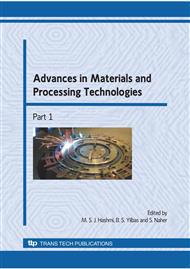[1]
D. Deng, H. Murakawa, Numerical simulation of temperature field and residual stress in multipass welds in stainless steel pipe and comparison with experimental measurements, Computational Materials Science, (2005).
DOI: 10.1016/j.commatsci.2005.07.007
Google Scholar
[2]
A. H. Yaghi, T. H. Hyde, A. A. Becker, J. A. Williams, W. Sun, Residual stress simulation in welded sections of P91 pipes, Journal of materials processing technology, (2005), 167, pp.480-487.
DOI: 10.1016/j.jmatprotec.2005.05.036
Google Scholar
[3]
F. Rick, G. Reinhart, G. Lenz, Advance finite element models for the simulation of laser welding, in: proceedings of the 17th International conference on the application of laser and electrooptics, USA, Orlando/Florida, (1998), pp.1-10.
DOI: 10.2351/1.5059165
Google Scholar
[4]
G. Donzella, S. Granzotto, G. Amici, A. Ghidimi, R. Bertelli, Microstructure and residual stress analysis of a rim chilled solid wheel for rail transportation system, Comput. Methods. Exper. Measure. Surf. Treatment effects 2, (1995), pp.293-300.
Google Scholar
[5]
M. Mochizuki, Sh. Matsushima, M. Toyoda, Z. Zhang, O. Gundersen, Ch. Thaulow, Generation behaviour of thermal and residual stresses due to phase transformation during welding heat cycles, ASME Pressure Vessels Piping Div. (Publication) PVP 434 (2002).
DOI: 10.1115/pvp2002-1115
Google Scholar
[6]
X. K. Zhu, Y. J. Chao, Effects of temperature-dependent material properties on welding Simulation, Comput. Struct. 80 (11) (2002) 967-976.
DOI: 10.1016/s0045-7949(02)00040-8
Google Scholar
[7]
P. Dong, The Mechanics of Residual Stress Distribution in Girth Weld, in Proceedings of the second International Conference on the Integrity of High Temperature Welds, London, UK, 10-12 November, (2003), pp.185-196.
Google Scholar
[8]
S. Nair, E. Pang, R. C. Dix, Residual stress generation and relaxation in butt-welded pipes, Journal of pressure vessel technology, (1982), Vol 104.
DOI: 10.1115/1.3264202
Google Scholar
[9]
A. Lundback, Finite element modeling and Simulation of welding of aerospace component, Licentiate Thesis, Division of computer aided design, Department of applied physics and mechanical engineering, Lulea University of technology, (2003).
Google Scholar
[10]
A. Thuvander, Calculation of distortion of tool steel dies during hardening, in: Proceedings of the second International conference on quenching and control of distortion, USA, Cleveland/Ohio, 1996, pp.297-304.
Google Scholar
[11]
B. L. Josefsson, Residual stresses and their redistribution during annealing of a girth-butt welded thin walled pipe, Pressure vessel Technol. 104, (1982), pp.245-250.
DOI: 10.1115/1.3264212
Google Scholar
[12]
J.R. Cho, B.Y. Lee, Y.H. Moon, C.J. Van Tyne, Investigation of residual stress and post weld heat treatment of multi pass weld by finite element method and experiments, Journal of materials processing Technology, (2004).
DOI: 10.1016/j.jmatprotec.2004.04.325
Google Scholar
[13]
ASM Handbook Vol. 4, Heat Treating, (1991).
Google Scholar
[14]
J. Dabbagh, Creep analysis in welding, MS thesis, Iran University of Science & Technology, (2000).
Google Scholar


